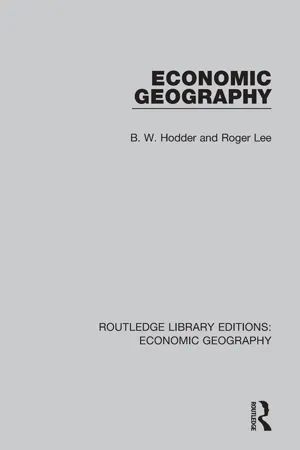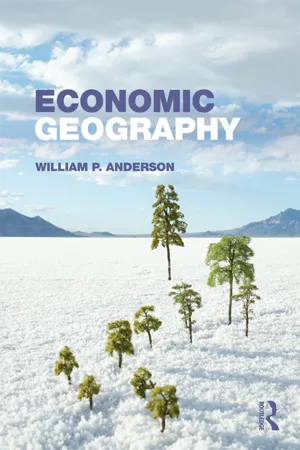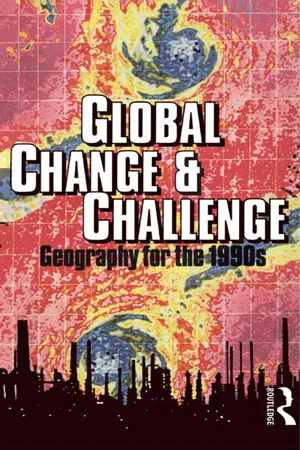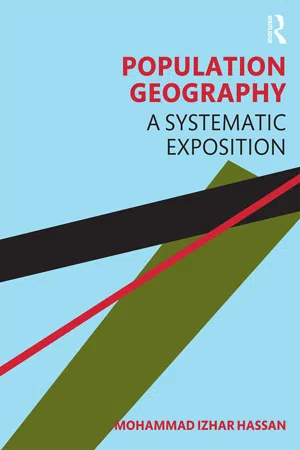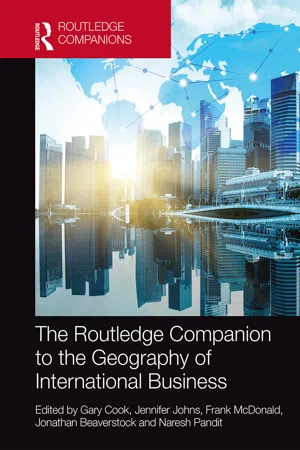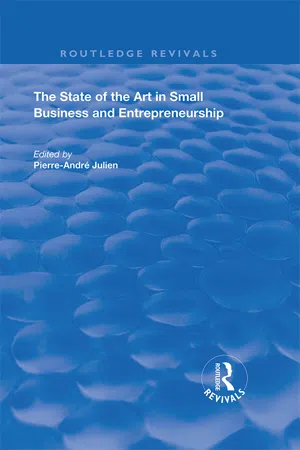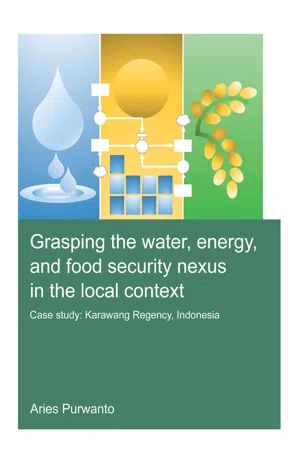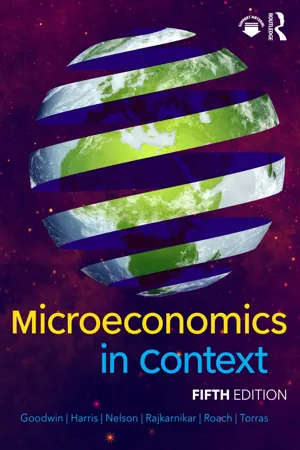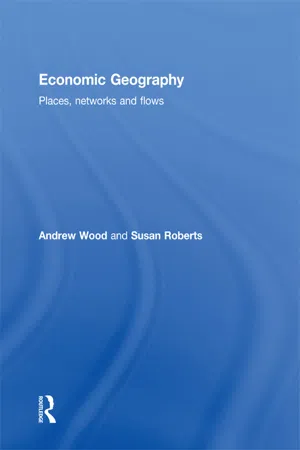Geography
Economic Sectors
Economic sectors refer to the different categories of economic activity within a country, including primary (agriculture, mining), secondary (manufacturing, construction), and tertiary (services, retail) sectors. These sectors are essential for understanding the distribution of economic activities and employment within a region, and they play a crucial role in shaping the overall economic structure and development of a country.
Written by Perlego with AI-assistance
Related key terms
Related key terms
1 of 4
Related key terms
1 of 3
9 Key excerpts on "Economic Sectors"
- eBook - ePub
- B. W. Hodder, Roger Lee(Authors)
- 2015(Publication Date)
- Routledge(Publisher)
fig. 1.3 , it should be noted that although the discussion has been conducted here in terms of city-regions and sectors, the logic of the argument is not altered if nations or world core areas are substituted for the city-regions.Conclusions
Three points can be made about this introductory and highly simplified description of the economy as a basis for the study of economic geography. First, it illustrates the essentially integrated nature of economies. Economic activity is generated by the individual elements of the economy — consumers, firms, resource owners and governments -and consists of their actions (e.g. the processes of demand-generation and consumption) and interactions (e.g. the exchange of information, commodities and payment). None of the individual elements is taken to have any meaning outside the context of the economy to which it belongs. In this sense the economy provides a focus and framework for the otherwise apparently discrete components of the subject matter of economic geography. At a very high level of generalization, integration of the kind noted here is common to all economies. Even a subsistence farmer within an almost closed and isolated economy is, in this sense, a much more complex economic man than is his equivalent within an open, highly specialized economy working, say, on a motor-vehicle assembly line. The subsistence farmer is simultaneously involved with the duties of a consumer, a firm, a resource owner and a government; moreover, he usually has not entirely separated out his ‘economic’ from his ‘non-economic’ activities. By contrast the ‘economic activities’ of the assembly worker are clearly distinguished and limited to consumption and resource marketing. Specialization of functions in a more developed economy has reduced the number of essential tasks that must be performed by its individual members, whilst the economy as a whole has become more complex as it must harmonize millions of individual decisions. By contrast, the task of harmonization in less specialized economies is accomplished, in large measure, by individuals and not by the economy as a whole. - eBook - ePub
- William P. Anderson(Author)
- 2012(Publication Date)
- Routledge(Publisher)
Part I Fundamental conceptsPassage contains an image
1 Introduction
DOI: 10.4324/9780203114988-2Economic geographers study and attempt to explain the spatial configuration of economic activities. Economic activities include all human actions that do one of three things: (1) produce goods and services, (2) transfer goods and services from one economic agent to another, and (3) transform goods and services into utility through acts of consumption. All of these activities must take place somewhere – but where? Why does a firm elect to locate its factory in a particular country, region, locality and site? Why is a retail outlet located on a main street, along a highway or in an enclosed mall? Why does a household choose to reside and consume in a particular city, suburb or rural county? These are the questions that economic geographers seek to answer.The answers to these questions depend on the decisions of a large number of interacting economic agents – firms, households, governments, and various private and public institutions. Each agent’s choice depends on choices that have already been made, or are anticipated, by other agents. Furthermore, all decision making is influenced and constrained by the spatial distribution of environmental resources such as minerals, climate, landforms, vegetation and natural transportation corridors.If it sounds complicated, it is. The role of the economic geographer, however, is to perceive order in all this complexity, to untangle webs of interrelated decision making and to elicit some basic principles that drive the evolution of the economic landscape. One way to do this is by building models, which attempt to abstract away from superfluous details and incidental interactions in order to focus on the main driving forces of the spatial economy. One must be careful though, complexity may in itself have implications for the evolutions of spatial patterns. Excessive abstraction may preclude an understanding of such implications. - eBook - ePub
Global Change and Challenge
Geography for the 1990s
- Robert Bennett, Robert Estall(Authors)
- 2012(Publication Date)
- Routledge(Publisher)
Economic development generally proceeds through a series of stages, in each of which certain kinds of productive activity achieve prominence. This process may be measured by using three broad categories (sectors) of activity: primary, secondary and tertiary. Early stages of economic growth (i.e. in ‘young’ regions) normally find most of the working population in primary activities, especially producing food or basic material requirements like fibre and lumber and some minerals. With the introduction of ideas that increase primary productivity, however, surpluses are created for sale. Incomes rise and more people are able to become engaged in the secondary occupations of manufacturing and construction (chiefly in manufacturing industry) which gradually become the key wealth-producing activity. But manufacturing must be supported (as must improved farming) by better services, especially at first the transport and trading functions. Thus the share of jobs in the primary sector steadily declines, while that in manufacturing and related services rises.As labour-saving technologies develop further, productivity in goods production (both primary and secondary) continues to improve. This creates more wealth, and it becomes possible for people to allocate an increasing share of their purchasing power to personal and other services. The services demanded by the goods-producing industries themselves also become more numerous, as in advertising, legal and financial services. As economies advance, therefore, a steadily rising share of the working population finds employment in the tertiary sector. These long-term trends are portrayed in a highly generalised way in Figure 6.1 , which reflects what is known as the ‘sector theory’ of growth.Such change in employment is reflected also, of course, in the contribution made by the different kinds of economic activity to a region's income. At a global level, we can conveniently regard whole countries as ‘regions’, and data available for the years around 1980 (Table 6.1 ) demonstrate the contrasts between old regions (like the UK, USA and West Germany), newly industrialising areas (like Mexico, Greece and Brazil) and poor Third World economies (like Bangladesh, Ethiopia and India). The three major sectors of activity have very different shares in the gross domestic product (GDP) of these countries, and this fact is directly reflected in the income of their populations.Figure 6.1 Shares of jobs at different stages of developmentThe economist Colin Clark, an early worker on sector theory, found a ‘firmly established relationship’ between a region's economic structure and its wealth. High levels of real income per head, he argued, were always associated with a high proportion of the working population engaged in tertiary activity. Low incomes were always associated with a high proportion in the primary. Not everyone accepts the certainty that Clark suggests, but the broad relationship is obvious. The final column of Table 6.1 - eBook - ePub
Population Geography
A Systematic Exposition
- Mohammad Izhar Hassan(Author)
- 2020(Publication Date)
- Routledge India(Publisher)
quinary sectors. The quaternary sector represents special types of service work, focussing on professional and administrative services, including financial and health service work, information processing, teaching and government services as well as entertainment activity (Hartshorn and Alexander, 1988:2). Finally, all activities related to high-level decision making in industry, business, education etc. in government as well as private sectors are included in the quinary sector. Research scientists, legal authorities, financial advisors and professional consultants who provide strategic planning and render problem-solving services come under this category (Hartshorn and Alexander, 1988:2). It may, however, be noted that separate data under quaternary and quinary sectors of the economy are generally not available. Therefore, the discussion in the present chapter is based on the traditional three-fold classification of economic activities viz. primary, secondary and tertiary sectors only. The percentage of workers in, say, the primary sector, for instance, can be worked out as under:Share of workers in primary sector =(9.4)× 100N o . o f W o r k e r s i n P r i m a r y A c t i v i t i e sT o t a l W o r k f o r c eIt can be seen that proportions across all sectors add up to 100. In the early stage of human history, primary activities engaged the entire workforce. Thereafter, as the economies evolved over time, a variety of non-primary activities came into existence and grew in importance. This process is called economic diversification and is accompanied by a gradual decline in share of the workforce in primary activities with a corresponding rise in other sectors. Looked at from this point of view, workforce structure of a population is a very good indicator of the stage of economic development a society has reached. The economies in less developed parts of the world have a relatively higher dependence on primary sectors of the economy while those in more developed parts report a larger share of the workforce in tertiary activities, including quaternary and quinary activities. Based on workforce or labour force participation rate and workforce structure, in the present chapter a geographical account of economic characteristics of population in the world is presented. It may be noted that the concern here is not with economic activities per se - Gary Cook, Jennifer Johns, Frank McDonald, Jonathan Beaverstock, Naresh Pandit, Gary Cook, Jennifer Johns, Frank McDonald, Jonathan Beaverstock, Naresh Pandit(Authors)
- 2018(Publication Date)
- Routledge(Publisher)
The on-going vitality and diversity of the Anglophone economic geographical research programme promises a bright future. Its practitioners, however, must be willing to engage constructively with one another and with scholars in cognate disciplines like economics and business studies. Economic geographers examine how economic processes shape, and are shaped by, geographical space (place, scale, connectivity, mobility); they examine how economic processes co-evolve with political, cultural and biophysical processes; they study how subject formation and identity at one end, and global political economic structures at the other, are interrelated; they take an interest in non-capitalist economic processes, and are critical of the proposition that regulated capitalist markets optimize societal wellbeing and ecological sustainability. Real-world oriented, economic geographers study some of the major challenges facing contemporary human society and its relation to political economic processes: global production networks, the politics and culture of consumption, work and labour, the role of state regulation and governance institutions, nature-economy relations, financialization, globalization and development, and diverse economic systems.p.126Of course, there are gaps in Economic Geography’s research programme. For example, much more needs to be done on logistics, a key to globalization, as well as on the frightening and pressing environmental challenges that the world faces such as global climate change. It is our hope, though, that these and other issues will be taken up in the spirit of engaged pluralism across different approaches, national communities and related disciplines.ReferencesAmin, A. & Thrift, N.J. (1992) ‘Neo-marshallian nodes in global networks’, International Journal of Urban and Regional Research , 16, pp. 571–587.Baldwin, R. (2006) Globalisation: The Great Unbundling(s) . Helsinki: Prime Minister’s Office: Economic Council of Finland.Barnes, T.J., Peck, J. & Sheppard, E. (Eds.) (2012) The Wiley-Blackwell Companion to Economic Geography- Pierre-Andre Julien(Author)
- 2018(Publication Date)
- Routledge(Publisher)
Despite these difficulties, and the variations to be taken into account according to the different small business types, we will attempt to summarize the main points of the current state of knowledge regarding the geographical distribution and location of small businesses, for various spatial scales. The chapter is divided into sections dealing with the commercial, service, and manufacturing sectors. The primary sector, including agriculture and mining, is excluded, as are construction, transportation, storage and finance (except banks). Each section is further subdivided to distinguish between geographical distribution and business location.It is important to mark the distinction between these two fundamental concepts. In geography, the expression “geographical distribution” is passive rather than active in meaning, since, with die exception of certain new services provided by the State (such as regional environmental services), no active, deliberate distribution of commercial, service-related or industrial activities in a given territory is actually carried out. Rather, the distribution results from a series of micro-decisions made by individual entrepreneurs, and the expression takes on a passive, static meaning that describes the arrangement or distribution of a given number of objects (in this case small businesses) in space. The expression “location” refers to the identification of a place or space in which to install a given object. Thus, location studies are carried out before a commercial or industrial activity begins, whereas geographical distribution studies take place at some point after activities have begun. The term “location” is thus dynamic, whereas the term “distribution” is essentially descriptive.After presenting a brief summary of existing distribution and location studies for commercial activities (including services for which a uniform demand exists throughout a given territory), for specific services (public and private) and for small manufacturing operations, we will underline the differences and similarities observed as regards location, especially for the purposes of analysis.2. Geographical distribution and localization of small businesses in the tertiary sector
In this section, we will examine the main elements influencing the geographical distribution of businesses, and then the stages of a business location study. A large amount of material exists in this field, and the discussion here will be limited to a description of the essential characteristics of each model, with emphasis on small businesses. It is not our intention here to discuss the operational definition of a tertiary-sector small business (c.f. introduction) given the numerous theoretical and methodological difficulties presented by such a diversified sector of activities. The central place theory will be described first, followed by a discussion of location studies and of specific examples of certain public and private services.- eBook - ePub
Grasping the Water, Energy, and Food Security Nexus in the Local Context
Case study: Karawang Regency, Indonesia
- Aries Purwanto(Author)
- 2021(Publication Date)
- CRC Press(Publisher)
Wang and Hofe (2007) proposed one of the assumptions related to basic and non-basic sectors, where basic sectors yield more goods or services than the local needs, so the surplus can be exported to other regions. On the contrary, the non-basic sector is assumed under the level of self-sufficiency and therefore unmet demand needs to be imported.One common method in economic base analysis is Location Quotient (LQ ). This technique has been employed in many sectors such as the mapping crime (Brantingham & Brantingham, 1998 ), trade sector (Chiang, 2009 ), industrial concentration (Billings & Johnson, 2012 ), and carbon emission (Trappey et al., 2013), marine sector (Morrissey, 2014 ), economic development (Alhowaish, 2015 ), and road project development (Berawi et al., 2017) among others. In addition, there are many studies employing the competitive position method to analyse various sectors (for instance Horta and Camanho, 2014 ; Dang and Yeo, 2017 ). However, although extensive research has been carried out on sector’s agglomeration analysis, no single study exists which focuses on water, energy, and food-related sectors in more detail and in the perspective of local economic and sustainable development. In this respect, this study is novel, and could yield new insight for policy makers, especially when developing sustainability targets, and when evaluating progress towards existing targets.This study analyses the agglomeration of WEF related sectors and other sectors in three characteristic local regions in Indonesia and WEF related sub-sectors in an agriculture–manufacture based region. This research also determines strategies for WEF related sectors based on agglomeration and competitiveness. This work analyses gross regional domestic product (GRDP ) in the year 2011-2015 and 2000-2015 using the combination of LQ techniques and competitive position charts (Zhao et al. - eBook - ePub
- Neva Goodwin, Jonathan M. Harris, Julie A. Nelson, Pratistha Joshi Rajkarnikar, Brian Roach, Mariano Torras(Authors)
- 2022(Publication Date)
- Routledge(Publisher)
within the core sphere. For example, the core sphere is where people generally raise children, prepare meals, maintain homes, organize leisure time, and care for mildly ill individuals.- The business sphere includes firms that produce goods and services for profit. Economists often assume that businesses operate only to obtain profits. But the final goals of many businesses may extend beyond simply maximizing profits.
- The public purpose sphere includes governments as well as other organizations that seek to enhance human well-being without making a profit. These may be anything from the United Nations down to a local homeless shelter.
core sphere: households, families, and informal community groupsbusiness sphere: firms that produce goods and services for profitable salepublic purpose sphere: governments as well as other organizations that seek to enhance well-being without making a profitIndividuals may move among these three spheres in their economic activities. A woman may be a wife and mother in the core sphere, a business executive in the business sphere, and a volunteer for an environmental group in the public purpose sphere.Economic activity within and between these three spheres always occurs within the social and environmental contexts. A useful understanding of economics must also take into account critical interactions between the economy and its contexts, showing how the economy is enabled and constrained by these contexts, and how the environmental and social contexts are affected by the economy.Although the contextual diagram does not specifically show the factor and product markets that were identified in the traditional model, one of the main ways that economic activities are organized among the three spheres is through markets. Although we will look at the important role of some nonmarketed activities in later chapters, we first turn our attention to a more detailed examination of markets in Chapter 2 - eBook - ePub
Economic Geography
Places, Networks and Flows
- Andrew Wood, Susan Roberts(Authors)
- 2012(Publication Date)
- Routledge(Publisher)
PART I
TRADITIONAL ECONOMIC GEOGRAPHIES
Economic geography is a broad and diverse field. Today, a significant number of economic geographers, regional scientists, planners and economists continue to work with and refine concepts drawn from what we are labeling ‘traditional economic geography.’ Traditional economic geography not only has deep roots but continues to develop and evolve. However, it should be pointed out that many economic geographers (and other social scientists too) deliberately ignore traditional economic geography on the grounds that they are not motivated by the same sorts of questions traditional economic geography asks, they do not use the same sorts of methods it favors, and they have different understandings of the broader social and political roles of economic geography.So, what are the hallmarks of traditional economic geography? First, there is an abiding commitment to rationalism. By this we mean that traditional economic geography is based on assumptions that the world can be known through observation and that it is fundamentally an ordered word. That is, that there are regularities and patterns that need to be identified and explained by the economic geographer. Further, the world's orderliness, including its spatial patterning, is itself the outcome of orderly economic processes, treated in many accounts as laws of economic activity. Orderly economic patterns and processes, in traditional economic geography, are seen as the outcome of rational decisions made by economic actors; typically individuals and firms. These rationalist underpinnings have come in for considerable skepticism and criticism, as Trevor Barnes has detailed in his writings on the history of ideas in economic geography (1996, 2000). However, the powerful discipline of economics is very much based on these foundations, as is much so-called common-sense understanding of the market or the economy, so it is not surprising that the approaches of traditional economic geography continue to attract many and, as Paul Plummer indicates, they most definitely have not been ‘consigned to the dustbin of intellectual history’ (Plummer 2000: 28). Indeed, it could be argued that through the attention given to geographical questions by such prominent economists as Paul Krugman, traditional economic geography approaches have been reinvigorated in the past decade or so. Certainly, a major methodological goal of traditional economic geography and of economics, ‘being able to produce tightly specified models’ (Krugman 2000: 59), continues to exercise many.
Index pages curate the most relevant extracts from our library of academic textbooks. They’ve been created using an in-house natural language model (NLM), each adding context and meaning to key research topics.
Explore more topic indexes
Explore more topic indexes
1 of 6
Explore more topic indexes
1 of 4
